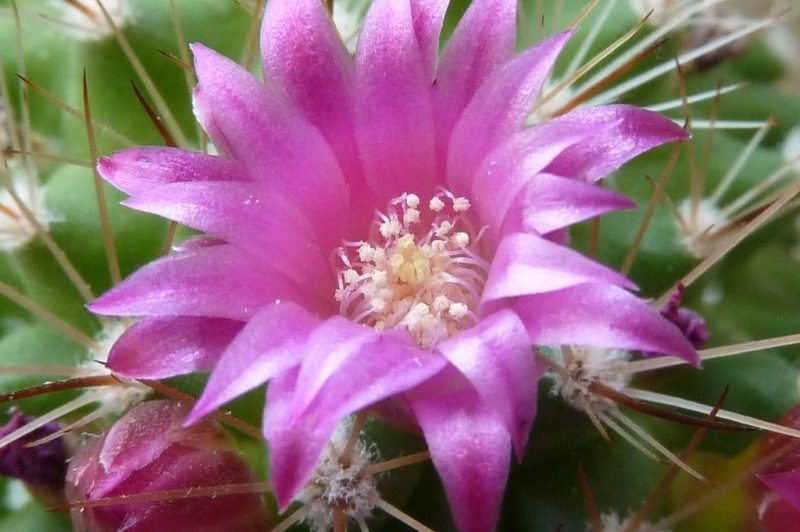You can learn how to get cactus to bloom using general care and dormancy. This is easy to achieve because cactus are already not demanding in terms of caring and attention. However, remember that there are 1200 species of cacti, which means you have to know your plants’ specific needs and adjust the practices accordingly.
While cactus is not one of those plants that struggle in challenging conditions, you can help them bloom much more comfortably in a consistent environment. You can achieve this with a greenhouse, significantly if your region experiences fluctuating climates. As you will read in this article, the general care and environment play a significant role in cactus blooming.

How To Get Cactus To Bloom: Beginner’s Guide
Factor #1. General care
Medium
The first factor to check is where you are keeping your cacti. Remember that standing water can cause rot, and a soggy medium itself can affect your cactus’ health, therefore, affecting blooming as well. You want to use a well-draining succulent potting mix to encourage your plants to flower and prevent diseases.
Temperature
The second environmental condition that you must check is the temperature. You want to provide a significant difference in day and night states to mimic cacti’s natural environment. For example, cool temperatures during the night are optimal for the plant’s growth cycle, and failure to achieve this can affect bloom formation.
Those who grow in the greenhouse can aim to have temperatures between 60 to 65⁰F during the night. Otherwise, check the outdoor conditions if it is around 50 to 55⁰F to ensure healthy plants. But what about the temperatures during winter?
A common reason why you do not see blooms on your cacti is you haven’t overwintered them. You want to place them somewhere dry and cool, but not freezing. You don’t have to provide heat in the greenhouse, but instead, a range between 35 to 44⁰F would be best during the winter months.
Light
The last environmental factor that can help your cactus bloom is the light they receive. This is especially important during spring and summer when the plants are actively growing. Receiving maximum light and heat should encourage blooming, so strategize their location or add grow lights if you have them in the greenhouse.
Aim to provide 6 hours or more of light for your cacti. Depending on the types you have, you may need to provide filtered light instead of intense full sun to prevent damaging the cacti. A promising sign indicating the plants not receiving enough light is a pale color and no flower formation.
Water
Besides the location itself, general care also refers to the practices you do for your cacti. Watering, for example, should encourage flowering. This can be confusing for some gardeners since cacti store water and generally tolerate drought.
Still, you want to water them regularly, especially during the active growing season. If the plants don’t experience a depletion of their water storage, they should bloom readily. However, overwatering will also be problematic, so check the top two inches of the soil first if it’s dry before watering.
Let the water drain to the bottom of the container and adjust watering depending on the climate. You may need to water more frequently during the summer and decrease the amount during winter. Overall, find the balance and never let the soil turn soggy nor dry.
Feeding
Fertilizing cacti is not necessary, but remember that adequate nutrients are crucial to encourage blooming. You can boost your plants by feeding them with a cactus fertilizer in spring until the beginning of summer. However, be mindful of providing within the recommendation since overfeeding will also prevent blooming.
Think of fertilizing as a supplement during the flowering season. You can dilute the fertilizer and feed every two weeks and then stop by the end of fall and never feed in winter. Check the fertilizer as you want something high in phosphorus and potassium and not nitrogen.
Factor #2. Dormancy
If you have ticked all the general care areas but still not seeing your cactus blooming, perhaps they need to undergo dormancy. Remember that most desert cacti will only flower in response to a dormant period. To encourage this, you must limit the amount of water and provide a dark and cool environment.
You can start watering your plants only once a month by winter and then place them in the greenhouse to create a cool and dark spot. Some gardeners also start cutting their watering by fall and have intervals of three to six weeks. On the other hand, the darkness period can begin by reducing the light the plants receive at two months before they bloom.
During the day, the cacti will still benefit from bright and indirect light. However, they will need around 12 to 14 hours of darkness to undergo dormancy. At this point, you can also place the plants somewhere between 50 to 60⁰F as inconsistent temperatures can affect their dormancy.
Conclusion
Cactus is not only a low-maintenance plant, but it is also capable of showing unique and attractive flowers. You don’t have to get frustrated in learning how to get cactus to bloom because general care and encouraging dormancy should get them flowering without issues. First, check the environment of your plants.
The medium, temperature, and light all affect the flowering of cacti, especially during the growing season. Feeding and watering are practices that you must also do properly to avoid problems in blooming. Lastly, most cacti should undergo dormancy to bloom since this mimics their natural conditions.
